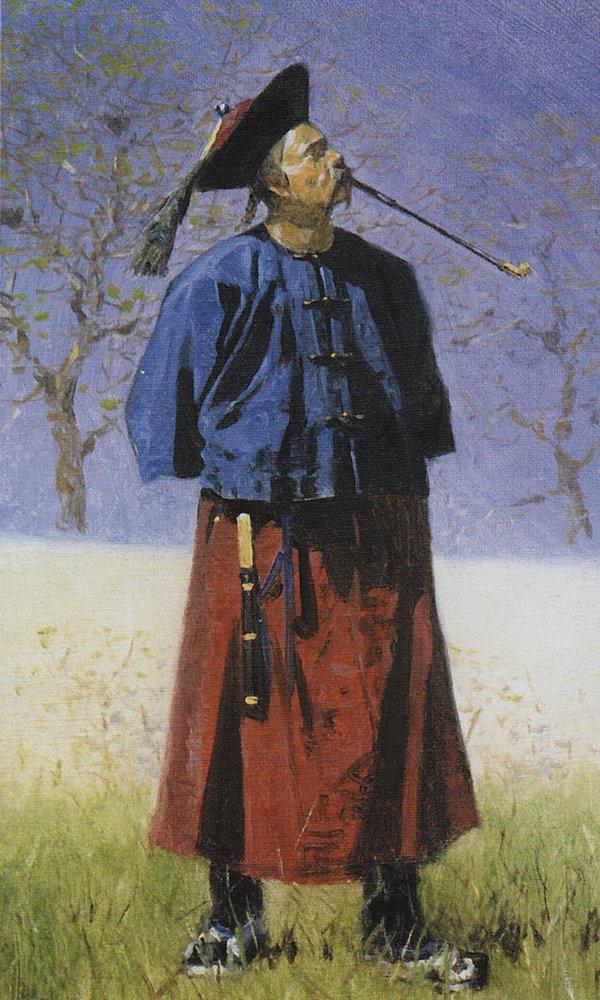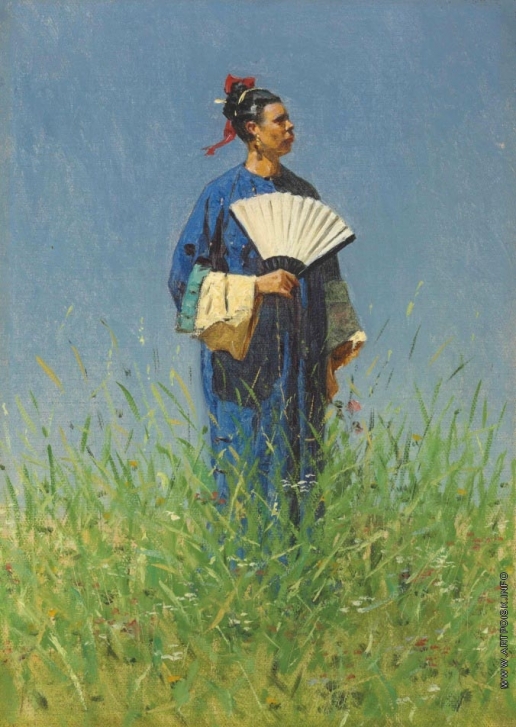Vasily Vereshchagin (V)
Развалины китайской кумирни. Ак-Кент (1869-1870) / Ruins of Chinese pagoda. Ak-Kent (1869-1870)
 Развалины в Чугучаке (1869-1870) / Ruins in Chugachuk (1869-1870)
Развалины в Чугучаке (1869-1870) / Ruins in Chugachuk (1869-1870)
"Tacheng (Qoqek/Sawesek) or Chöchek is a county-level city (1994 est. pop. 56,400) and the administrative seat of Tacheng Prefecture, in northern Ili Kazakh Autonomous Prefecture, Xinjiang, one of the autonomous regions of China.
The city was sometimes called Tarbaghatay or Tarbagatai (Mongolian: 'having marmots') and was once known in European languages as Chuguchak (based on its name in the Mongolian language). The current Uyghur name is Qöqäk Xäĥri.
It is located in the Dzungarian Basin, some 10 km (6.2 mi) from the Chinese border with Kazakhstan. For a long time it has been a major center for trade with Central Asia because it is an agricultural hub. Its industries include food processing, textiles, and utilities.
The city suffered harshly in 1865, during the fighting between the Qing forces and the Dungan and Uyghur rebels."
Text by Wikipedia.
 Развалины театра в Чугучаке (1869-1870) / Ruins of the theater in Chugachuk (1869-1870)
Развалины театра в Чугучаке (1869-1870) / Ruins of the theater in Chugachuk (1869-1870)
 Садовая калитка в Чугучаке (1869-1870) / Garden gate in Chugachuk (1869-1870)
Садовая калитка в Чугучаке (1869-1870) / Garden gate in Chugachuk (1869-1870)
 Китайская палатка (1869-1870) / Chinese tent (1869-1870)
Китайская палатка (1869-1870) / Chinese tent (1869-1870)
 Китаец (1873) / Chinese man (1873)
Китаец (1873) / Chinese man (1873)
 Китаянка (1873) / Chinese woman (1873)
Китаянка (1873) / Chinese woman (1873)
 Китайский чиновник племени сибо (1869–1870) / Chinese official of tribe Sibe (1869–1870)
Китайский чиновник племени сибо (1869–1870) / Chinese official of tribe Sibe (1869–1870)
"The Sibe or Xibo (pinyin: Xībó) are a Tungusic people living mostly in Xinjiang, Jilin (bordering North Korea) and Shenyang in Liaoning. The Sibe form one of the 56 ethnic groups officially recognized by China.
The Sibe are known by several variations of their name. The self-appellation of the Sibe people is pronounced Śivə, the official Chinese term is Xibo, in Russian literature the terms sibin'ci / šibin'ci are used, while in English works the name Sibe has been established, which corresponds to the written form.
According to the Russian scholar Elena P. Lebedeva, the Sibe people originated as a southern, Tungusic-speaking offshoot of the ancient Shiwei people. They lived in small town-like settlements, a portion of them nomadic, in the Songyuan and Qiqihar areas of what is now Jilin.
When the Buyeo kingdom was conquered by the Xianbei in 286, the southern Shiwei started practicing agriculture. Some historians have theorized that the Xianbei were the direct progenitors of the Sibe, a theory described as politically motivated. Pamela Kyle Crossley writes the Xianbei might have undergone a language shift from an earlier Turkic or proto-Mongolian language to a Tungusic one. However, the name "Sibe" was not used in historical records during Xianbei times.
The Han, Cao Wei, and Jin dynasty (265–420) at times controlled the Sibe until the advent of the Göktürks, who accorded the Sibe lower status than did the Chinese dynasties. At the height of their territorial dispersion, the Sibe lived in an area bounded by Jilin to the east, Hulunbuir to the west, the Nen River to the north, and the Liao River to the south. After the fall of the Liao dynasty, the Sibe became vassals of the Khorchin Mongols who moved to the Nen and Songhua river valleys in 1438 after the Khorchin were defeated by the Oirats.
Nurhaci, the founder of the Manchu people, routed the Sibe during the battle of Gure in 1593 on his way to founding the Qing dynasty of China. From that point, the Qing contracted the Sibe for logistical support against the Russian Empire's expansionism on China's northern border. Crossley claims that the Sibe were so "well known to Russians moving toward the Pacific" that the Russians named Siberia after them. In 1692, the Khorchin dedicated the Sibe, the Gūwalca and the Daur to the Kangxi Emperor in exchange for silver. The Sibe were incorporated into the Eight Banners and were stationed in Qiqihar and other cities in Northeast China.
In 1700, some 20,000 Qiqihar Sibes were resettled in Hohhot (modern Inner Mongolia); 36,000 Songyuan Sibes were resettled in Shenyang, Liaoning. The relocation of the Sibe from Qiqihar is believed by Gorelova to be linked to the Qing's complete annihilation of the Manchu clan Hoifan (Hoifa) in 1697 and the Manchu tribe Ula in 1703 after they revolted against the Qing. According to Jerry Norman, after a revolt by the Qiqihar Sibes in 1764, the Qianlong Emperor ordered an 800-man military escort to transfer 18,000 Sibe to the Ili River of Dzungaria.
In Ili, the Xinjiang Sibe built Buddhist monasteries and cultivated vegetables, tobacco, and poppies. The Sibe population declined after the Qing used them to suppress the Dungan Revolt (1862–77) by the Hui, and to fight against the Russian occupation of Ili during the revolt. During the Republic of China (1912–49), many northeastern Sibe joined anti-Japanese volunteer armies, while northwestern Sibe fought against the Kuomintang during the Ili Rebellion."
Text by Wikipedia.
 Дети племени Солонов (1869-1870) / The children of the tribe Solon (1869-1870)
Дети племени Солонов (1869-1870) / The children of the tribe Solon (1869-1870)
"The Solon people are a subgroup of the Ewenki (Evenk) people of northeastern Asia. They live in China's Inner Mongolia Autonomous Region and Heilongjiang Province, and constitute the majority of China's Ewenki.
The Ewenki (also spelled Evenki) people are spread throughout the taiga forests of much of northeastern Asia, including most of Eastern Siberia and parts of Northeastern China. According to Juha Janhunen's classification, the Ewenki people found in China can be classified into three subethnic groups:
The Solon (Suǒlún Èwēnkè, "Solon Ewenki")
The Orogen
The "Manchurian Reindeer Tungus" - a small group which are known to the Chinese as the "Yakut" (Yǎkùtè Èwēnkè, "Yakut Ewenki"). They are the only group in China engaged in reindeer herding.
Another subethnic group in China's Inner Mongolia, the Khamnigan are bilingual, speaking the Ewenki language along with a Mongolian dialect. Janhunen believes that their primary ethnic affiliation is Mongolian rather than Ewenki, and does not include them into his classification of China's Ewenki.
The above classification is different from the PRC's official classification, according to which the Oroqen are considered a separate ethnic group, while the official Ewenki ethnic group of China includes not only the Solons and the "Manchurian Reindeer Tungus", but also the Khamnigan (or, officially, the "Tungus Ewenki", Tōnggǔsī Èwēnkè).
As both the "Manchurian Reindeer Tungus" and the Khamnigans are quite small groups (perhaps around 200 persons in the former, and under 2,000 in the latter, as of the 1990s), the majority of the people classified as "Ewenki" in China are Solons. The Solon population was estimated as 7,200 in 1957, 18,000 in 1982, and 25,000 in 1990.
According to Janhunen's analysis, the Oroqen are in fact much closer to the "Ewenki proper" (i.e., the Evenks of Siberia) than the Solon are. The Solon are characterized by their close association with the Daur people. The Solons reside in the same areas where Daur do, in particular, in Evenk Autonomous Banner of Inner Mongolia, and elsewhere throughout the prefecture-level city of Hulunbuir. While the Solon language itself is a dialect of the Evenki language, most of the Solons are also bilingual in the Mongolic Daur language.
In 1763, a number of Solon bannermen, along with their Daur and Xibe comrades-in-arms were resettled from Manchuria to the frontier regions of the recently conquered Xinjiang. These Solon became also known as the "Ongkor Solon". The presence of the Solons in the region is attested in numerous Russian accounts, in particular from the time of the Muslim minorities' war and its aftermath.
Unlike Xinjiang's Xibe, who preserve their ethnic identity into the 21st century, the less numerous Solon settlers gradually assimilated to the Dagur and Xibe. While over 100 Solons still lived in Xinjiang in 1905-1908, less than 20 people identified as Solon in the region in 1991. In 1990, only one Solon speaker remained in Xinjiang; he was 79 years old."
Text by Wikipedia.
 Мальчик солон (1869-1870) / Solon boy (1869-1870)
Мальчик солон (1869-1870) / Solon boy (1869-1870)
